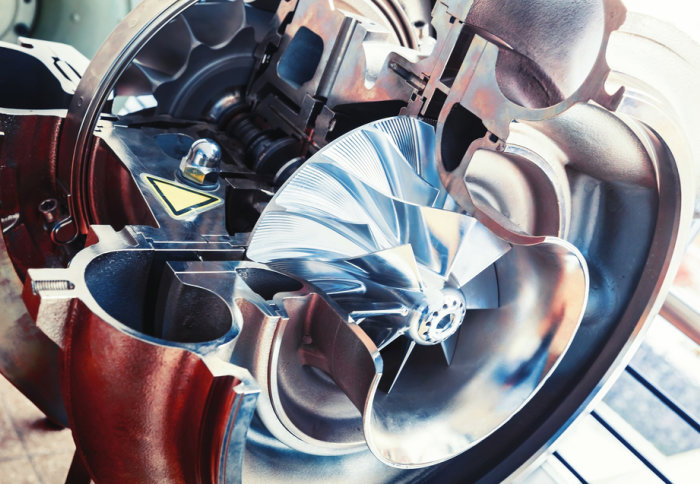

Imperial College London have been partnering with Mitsubishi Heavy Industries (MHI) since 2005 to improve turbocharger design.
Greening the turbocharger industry
Imperial is a recognised centre of excellence in turbocharging and exhaust gas energy recovery. In particular, it applies experimental methods and advanced computational procedures to enhance our understanding and deliver impact for industry. It has attracted substantial support from Government agencies as well as from the turbocharger and automotive industries.
Long-term partnership with a world-leading manufacturer
Mitsubishi Heavy Industries Ltd (MHI) is a key collaborator with Imperial and has invested in a major partnership that began in 2005. The collaboration has had a significant impact on MHI, with substantial improvements in turbocharger design as a result of more advanced measurement techniques and simulation tools.
MHI makes industrial machinery and equipment, including the manufacture of gas turbines, turbochargers and internal combustion engines. It is a global leader in R&D investment, spending £1bn in FY2016, enabling it to enhance its competitiveness, particularly in the energy and environment sectors.
The Imperial-MHI partnership has to date mainly focused on improving technologies in enhanced turbochargers, and enhancing ways for evaluating them. It is led by Professor Ricardo Martinez-Botas, who heads up the Turbocharger Group and the Thermofluids Division in Imperial’s Department of Mechanical Engineering.
Strong research base
Professor Martinez-Botas and his research group work on the unsteady flow aerodynamics of turbines. Their strong track record includes improving turbomachinery design, with new ways of managing air so that engines can better harness exhaust energy and enhance energy efficiency.
The researchers have also advanced modelling strategies for improving the selection and matching of optimal turbochargers to appropriate engines. Their high-speed dynamometer improves our understanding of turbocharger flow conditions and turbine performance across a broader operating range than just the design point. The researchers have also developed the Active Flow Control Turbocharger patented technology, as well as other turbo technologies currently in the portfolio of Imperial Innovations.
My team has worked closely with a leading global player on real and significant problems. All of this makes impact at a large scale. We are now tackling new challenges that will keep us busy for quite a while! Professor Ricardo Martinez-Botas Professor of Turbo-machinery
Fruitful relationship
Imperial’s partnership with MHI has harnessed the expertise of Professor Martinez-Botas and his research group, enabling them to apply their knowledge and tools to solve a range of industry-led problems. The most significant recent impact has come from a new turbine, which has improved performance under pulsation and led to improvements in engine level fuel economy. The conventional radial turbine has been replaced with a modified turbine blade in a new volute that brings out the system’s potential under a pulsating condition. A joint patent on the volute was filed in 2013 and series production began in 2016. In the same year it received MHI’s Best Innovation Award.
The successful Imperial-MHI partnership has subsequently led to other concepts for MHI, including a new turbine nozzle and compressor volute. More recently, a new testing procedure has been jointly implemented in the Turbocharge Technology Laboratory at Imperial, which could make significant improvements in our current understanding. Other outputs include joint publications and PhD training.
"The work with MHI has not just advanced our understanding of exhaust turbochargers for cleaner engines, but it also has enabled new concepts to be created based on this understanding," said Professor Martinez-Botas. "My team has worked closely with a leading global player on real and significant problems. All of this makes impact at a large scale. We are now tackling new challenges that will keep us busy for quite a while!"
Good quality R&D is the bedrock of our business. In Imperial College London we have found a longstanding partner who can help us to deliver cutting edge products. We look forward to many more years of rewarding research collaborations. Seiichi Ibaraki MHI Research & Innovation Centre
Broader impact
In 2017, the new partnership expanded to cover work with the Combustion and Tribology Research groups. For example, work with Professors Alex Taylor and Yannis Hardalupas has led to a research programme for combusting two phase flows. A collaboration with Dr Amir Kadiric is working on an analytical model for understanding of contact behaviour in relation to efficiency and reliability improvement in mechanical components.
At the same time, a collaboration between MHI and the Centre for Low Carbon Transport in cooperation with Imperial College London at the University of Technology, Malaysia (UTM) has been launched to translate concepts from the Imperial-MHI partnership to realistic engine conditions.
Future collaboration
In addition to the impacts described above, the Imperial-MHI partnership has generated a healthy pipeline of future collaboration opportunities. These include technology for further improvement of the turbocharger and turbocharging system for future powertrains.
For further information, please contact Dr Rebeca Santamaria-Fernandez, Head of Corporate Partnerships, Engineering r.santamaria-fernandez@imperial.ac.uk
Article text (excluding photos or graphics) © Imperial College London.
Photos and graphics subject to third party copyright used with permission or © Imperial College London.
Reporters
Naomi Black
Enterprise

Contact details
Email: press.office@imperial.ac.uk
Show all stories by this author
Natasha Martineau
Enterprise

Contact details
Email: press.office@imperial.ac.uk
Show all stories by this author



